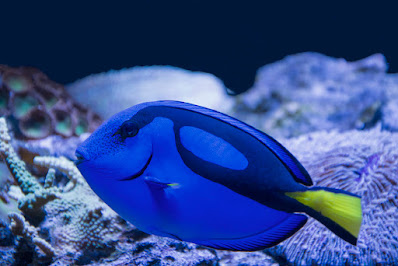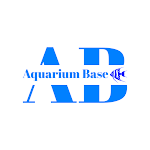Regal tang, is one of the most popular and common marine fish. The striking coloration and patterning have made it a firm favorite with aquarists.
Regal tang, also called as Palette surgeonfish, Blue tang, Royal blue tang, Hippo tang, Blue hippo tang, Flagtail surgeonfish, Pacific regal blue tang, Blue surgeonfish and its scientific name Paracanthurus hepatus, is one of the most popular and common marine fish. Its popularity was solidified along with the Orange and white clown fish in the film “Finding Nemo” and “Finding Dory”.
REGAL TANG DESCRIPTION:
Regal tang can be found in the reefs throughout the Indo-Pacific Ocean. They live pairs, or in small groups of 8 to 14 individuals and don’t just hang out with their own kind, either. They include several different species of surgeonfish and tang in their schools. Belong to group of fish called surgeonfish due to sharp spines on caudal peduncle (near tailfin). Spines are used only as a method of protection against aggressors. They can also be found near cauliflower corals on the seaweed side of coral reefs.
Palette surgeonfish is one of the most traded aquarium fish, especially because of its swimming behaviour and beautifully coloured pattern. The striking coloration and patterning of these fish are distinctive, with a black stripe running through the eye to the tail on each side of the body, and looping around beneath to create a blue oval bordered by black. The tail is yellow, with black edging at top and bottom. Young fish are bright yellow. As adults, the fish will turn deeper blues and violets as a sign of stress.
Paracanthurus hepatus can live up to 30 or more years and reach lengths of 25-31 cm in the wild but less in aquaria. Males are typically larger than females. They may look relatively harmless, but when in danger they can raise a pair of razor-sharp, venomous spines on either side of their tails. The fish then whip their bodies from side to side, threatening to stab predators with their toxin-tipped stingers.
When it is time to reproduce, Palette surgeonfishcongregate in breeding groups. Females expel their eggs into the water above the coral, and the males expel sperm, and fertilization occurs externally. About 40,000 eggs are expelled per spawning session. After spawning, the parents swim off, never caring about their offspring. The fertilized eggs are cast adrift and become part of the plankton "soup". About 26 hours after fertilization, the eggs hatch and live in the soup until it is time to metamorphose into juveniles. At that point, they settle into a coral habitat, where they complete the metamorphosis.
REGAL TANG CARE:
Regal tang require large tanks to live comfortably, with water temperature of 26-28 °C, alkaline (pH 8.1-8.3), specific gravity of 1.021-1.024, with several rocks and places to hide as well as plenty of room to swim around. A reef aquarium with corals is recommended for better maintenance of the species. Tanks should also be equipped with basic filtration units, including mechanical, biological, and UV sterilizers as well as heaters or chillers and proper illumination. In this way water chemistry (ammonia, nitrites, and nitrates), temperature, and photoperiod will remain constant and at optimum levels.
Palette surgeonfish are omnivores and have been known to eat tiny aquatic creatures known as plankton, most of their diet comes from algae. They will readily eat most meaty and dry foods offered to them. It is usually possible to wean these tangs onto a variety of foods, but initially they will instinctively seek out vegetable matter. They should be fed several (at least 3 times a day) with small amounts of food including Artemia and Mysid shrimps, vegetables (like lettuce), seaweed, and algae. But it is important that they are also provided plenty of marine based seaweed such as nori. The nori can be tied to pieces of PVC pipe, to a rock or special vegetable clips and it is best to feed at least three times per week. This approach will help the fish's immune system leading to overall good health.
Though peaceful towards most tank mates, the Palette surgeonfishcan become aggressive towards other tangs if there is insufficient hiding locations provided. If you wish to introduce multiple tangs, it is advised to add them all at the same time, which will lessen the chance of aggression.
REGAL TANG DISEASES:
Like other marine ornamental fish caught in the wild and kept in captivity, Paracanthurus hepatus can develop health problems related to several factors encountered along the “chain of custody”, from capture to aquaria. For this reason, its introduction in the confined environment of the aquarium always has to be always carried out with careful acclimation and ensuring a readily available proper diet and suitable environmental parameters.
Head and Lateral Line Erosion Syndrome is the most frequent disorders encountered by Regal tang. The affected fish displays depigmented erosions on the head, often around eyes, that can progress in large and deep ulcers, and extend along the lateral line. HLLE has been linked to different causes and currently there is not a single and unequivocal etiology. In the past, its occurrence has been correlated to parasitic and viral infections, exposure to metals (i.e., copper), nutritional deficiencies in vitamins A and C, scarce vegetation in the aquarium, poor lighting, high levels of nitrate, use of ozone or UV, and certain kinds of activated carbon (i.e., extruded coconut shell). Whatever the triggering factor, the syndrome evolves overtly under the influence of stressful factors such as poor water quality, improper diet, and overcrowding. For this reason, treatment of HLLE should rely on the elimination of any potential stressors present in the aquarium environment.
Another common disorder in marine ornamentals is thyroid goiter, a metabolic syndrome due to hyperthyroidism. This disorder was related to the presence of high levels of nitrates in the water, a factor that would inhibit the capacity of the thyroid gland to utilize iodide from the tank water, with consequent development of goiter. Furthermore, the ozonation of aquarium water can also cause a reduction in available environmental iodide and is currently included among goitrogenic factors for fish cultured in recirculated marine water systems. As a consequence, in these systems an iodide supplementation through the diet and/or tank water is always advisable.
Among parasites, the ciliate Cryptocaryon irritans is quite common in Regal tang, causing "marine white spot disease". This protozoan finds in the aquarium optimal conditions for its development, replicating on the bottom and presenting a polyphasic life cycle positively regulated by temperatures around 25 °C. The obligate parasitic feeding stage (trophont) of C. irritans lives encysted in host gills, eyes, and skin epithelia, with the emergence of small white spots visible by the naked eye at these sites. Marine white spot disease may represent a serious disease mainly in juveniles, while in adults the infection shows a cyclic occurrence with less serious consequences in absence of secondary bacterial infections. This parasite has been isolated in several marine species, mainly coral reef fish, and its introduction into the aquaria should be avoided by appropriate quarantine and health checks. Treatment is mainly aimed at killing the environmental stages, in particular infective stages, by different methods.
In general, improved knowledge on good management practices for Palette surgeonfish kept in aquaria, with specific reference to its environmental, ecological, and nutritional requirements, will go a long way toward preventing disorders and diseases and ensuring high levels of welfare and health during the aquarium life of this fascinating fish.
BUY REGAL TANG AND RELATED PRODUCTS:














COMMENTS